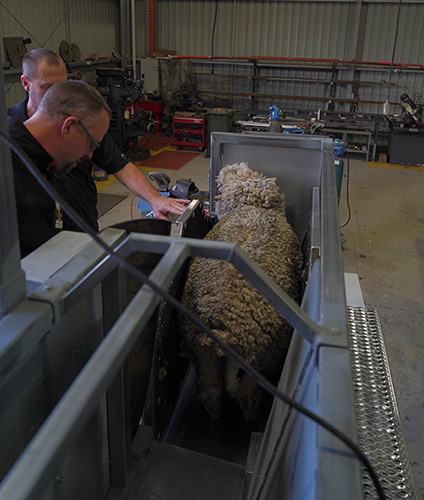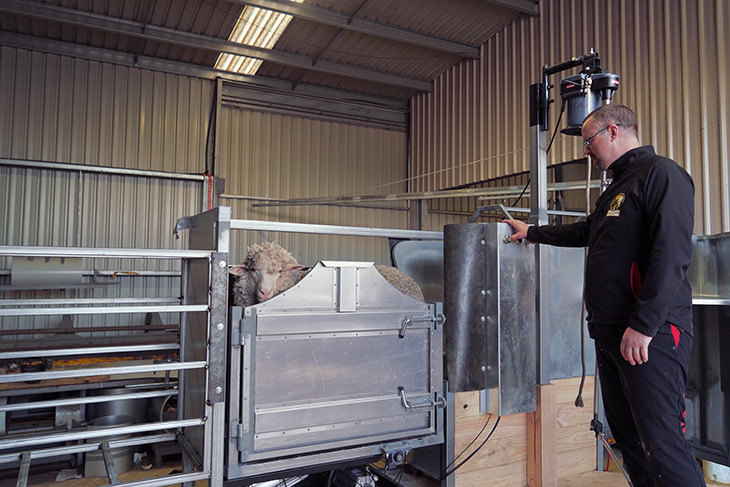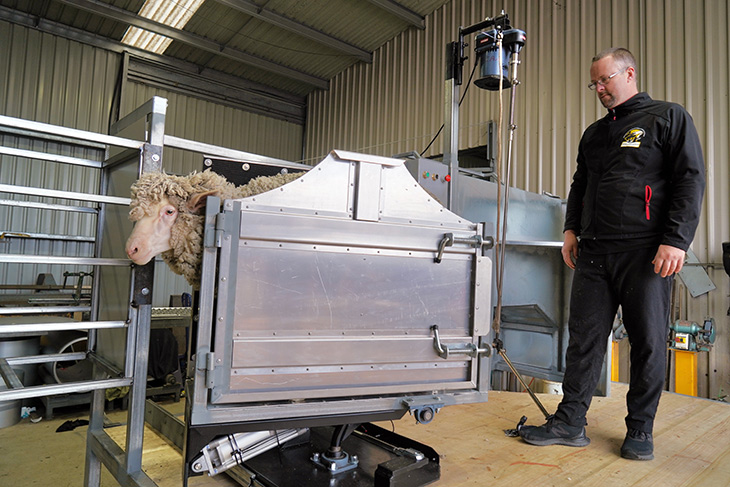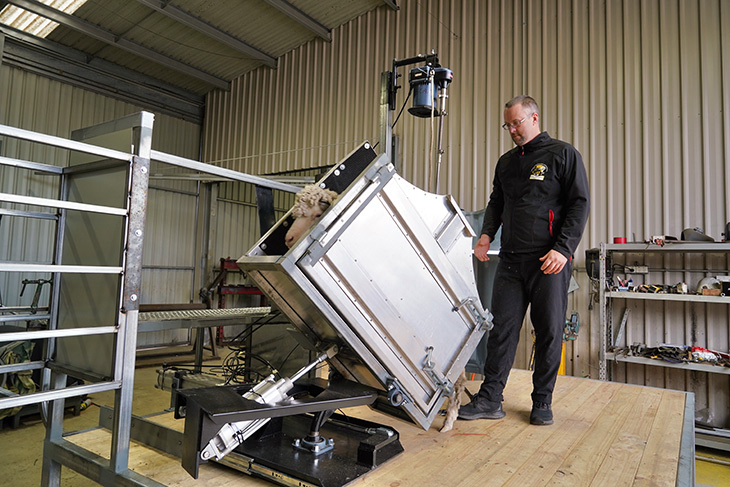Shearer Josh Sneath with the prototype of the unit, showing how the sheep has been delivered directly to him, ready to start shearing. The empty unit is automatically returning to its position behind the board, for the next sheep.
As part of a new AWI project, a mechanical system is under development that delivers the sheep to the shearer, thereby eliminating the catch and drag from the pen. This minimises the chance of injury to the shearer and the sheep whilst also maximising productivity with significantly reduced handling times.
- Question: Which process impacts the efficiency of wool harvesting the most? Answer: The catch and drag.
- Question: During which process do most shearing injuries occur? Answer: The catch and drag.
“These negative impacts of the catch and drag are the motivation behind a new AWI project that is developing an alternative system in which sheep are delivered from a race directly to the shearer,” said AWI CEO Stuart McCullough.
“Significantly, the new system will not only eliminate the time and energy that shearers spend having to walk to the pen, catch a sheep and drag it back to the shearing stand, but it also minimises the chance of injury to the shearer from the dragging and twisting movements.”
Overall, the AWI-funded project aims to produce a design for the workplace that:
- improves efficiency for workers, and the flow of livestock
- provides safety for workers
- enables quality wool preparation
- provides minimal risk to the welfare of livestock
- minimises the cost of equipment and ease of uptake
- is compatible with existing equipment, harvesting systems and skill sets.
The project is the brainchild of AWI’s Stephen Feighan and SCAA Training’s Glenn Haynes and is progressing well under the guidance of a number highly experienced AWI Shearer Trainers – Shannon Warnest, Paul Oster and Wayne Hosie – all of whom are renowned shearers and have considerable hands-on experience in sheds and on other shearing race delivery systems across the world. They know the practicalities of what works and what doesn’t.
The design focuses on a ‘modular’ concept in which portable singular shearing stands can be joined together to make a multi-stand shearing platform, which can be stored away after use. Added design elements will allow for straight board or U-shape configuration.
Former world champion shearer Shannon Warnest, who initially came up with the tilting delivery unit concept, said: “Everyone involved in this project is rapt with the progress. We’ve also made sure to get feedback from a number of other practical, experienced shearers and some growers who are looking to upgrade their sheds.
“We’ve had a few people shaking their head when they first see it – but not for long.”
Stuart added: “This is an additional harvesting option, especially suitable for woolgrowers that might have been planning to renovate an old shearing shed or build a new a multi-purpose shed.
“Building a brand-new shed is a big undertaking, in terms of cost, time and energy, especially when it’s often only used for a few weeks of the year. A portable, modular system could be cheaper and easier – and by eliminating the catch and drag from the pen it also provides a more efficient and safe environment for the shearer.
“It’s vital for the future of wool-growing industry that harvesting workplaces have a modern environment, such as this, to attract workers into the industry and retain the current workforce.”
The delivery system
The design incorporates a pneumatically powered race section on which the sheep is delivered to the shearer, removing the catch and drag from a pen.
Each modular unit will hold three sheep in a race at the back of the unit. A dummy pen is fitted onto the end of the race to assist with the flow of the sheep.
When the shearer is ready for a sheep to be delivered, he/she presses a button and the section containing a sheep clamps the sheep securely and slides out onto the board towards the shearer. The section then tilts the sheep into a position suitable for the shearer to then hold the animal.
The sheep is then mechanically released and slides the short distance to the shearing platform, at an angle suitable for the shearer to start shearing straight away. Unlike upright shearing units, the shearer does not have to learn any new shearing technique or blow patterns with this system.
Once shorn, an angled shoot allows for simple release of the shorn sheep underneath the race – again without significant dragging or twisting.
By minimising the catch and drag, it is estimated that the system could save the typical shearer approximately 10 to 20 seconds per sheep, which on average could add up to about three-quarters of an hour each day.
A portable, modular system
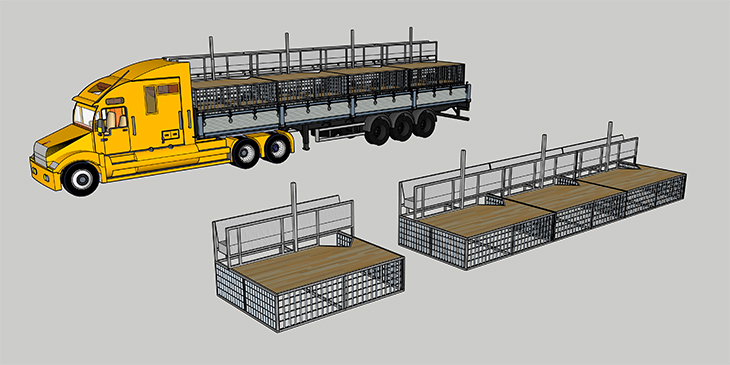
The new system is based on a modular design in which single units can be connected to other units at shearing time and moved away afterwards.
Each modular one-stand unit will be able to be connected to other one-stand units to make a multi-stand shearing platform, the size of which depends on the number of shearing stands required. Initial cost modelling shows the individual units to be available to growers for approximately $18,000, which would be a very attractive option when fitting out a shearing shed. This has the potential to be reduced further with broader uptake from manufacturers.
Being easily portable, the modular units can be transported to other sheds, be that on the same or other properties. They could be used in any multi-purpose machinery shed and can be relocated with a forklift when not in use.
The potential benefits for woolgrowers and the industry include:
- increased attraction and retention of shearers to the industry
- decrease in shearer injuries
- cost effective option when upgrading infrastructure
- provides an avenue for multi-purpose sheds.
Further development and testing of the unit(s) is continuing and AWI will make available the design and specifications, so interested woolgrowers or manufacturers can adopt and potentially further enhance the concept. This approach is similar to AWI’s Arrow Park Shed Design project, which has now been replicated about 50 times by growers and builders across the country since 2019.

